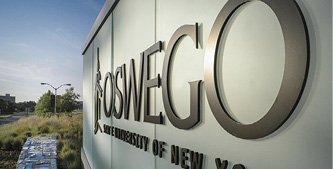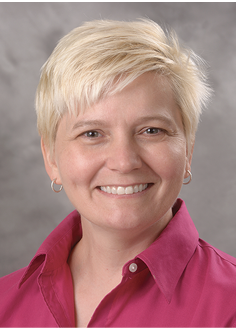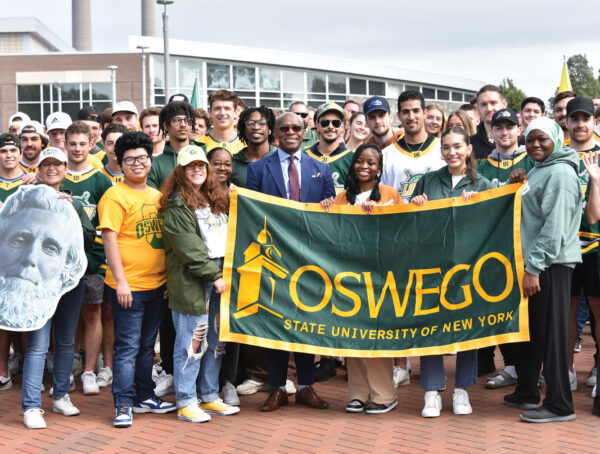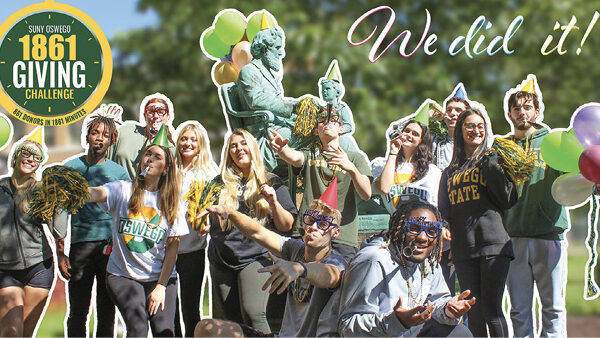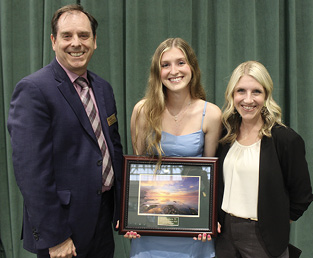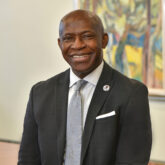The holiday classic, “It’s a Wonderful Life,” tells the story of what the world would be like if the protagonist, George Bailey, had never existed. A disheartened George, accompanied by an angel, travels back in time and begins to realize the impact that he has had on many people’s lives. At the climax of the movie, George reaches into his pocket for the flower petals his daughter Zuzu had given him, and experiences the biggest blow of all. If he never existed, then he never married, nor had any children. He would leave behind no legacy, no impact on the world.
 Now, let’s imagine for a minute that SUNY Oswego never existed.
Now, let’s imagine for a minute that SUNY Oswego never existed.
The thousands of teachers—educated since the college’s founding within Dr. Edward Austin Sheldon’s framework of employing applied learning techniques and finding ways to engage all kinds of learners—would never have reached the inside of the classrooms. Tens of thousands of school children would have missed the hands-on, minds-on lessons and the nurturing ways of SUNY Oswego alumni educators.
The region would not benefit from the new degree programs that educate the workforce for the in-demand jobs of today and tomorrow, such as the planned interdisciplinary degree in informatics and in engineering (see page 13).
Faculty members, like those described in “Snapshots: Faculty Research and Creative Work” of this issue, would not be conducting their research that advances the understanding of subjects ranging from the impact of lead exposure on children’s health to the optimal habitat of bog turtles to using technology to help reduce people’s stress.
The School of Business would not be partnering with SRC Inc. to offer a customized MBA program to the scientists at the Syracuse-based company, nor helping those employees build their managerial and leadership potential.
Our alumni would not be returning to campus to share their expertise and advice with current students, thereby giving those young people the confidence and acumen to succeed in their first jobs.
 Efforts to provide affordable, high-quality education to underrepresented and low-income students would be diminished in the region.
Efforts to provide affordable, high-quality education to underrepresented and low-income students would be diminished in the region.
The college’s nearly 700 acres of lakefront property could have been developed into private homes or condos, removing one of the most scenic public spaces from the view of thousands each year. One can only imagine the number of Laker marriage proposals that happened along those shores—and the number of love stories that never would have started without SUNY Oswego.
The local community would have missed out on hundreds of opportunities each year to visit art exhibition openings, concerts, lectures, sporting competition and campus events.
Oswego County would be without the $179.4 million of economic stimulus created by the college, and the seven-county region would be deprived of $345 million brought in by the college. A total of 1,730 full- and part-time employees, plus an additional 3,236 part-time student employees, would need to find jobs elsewhere. And the catalyst for new job creation and business incubation would move to a different communityf.
All in all, throughout its 154-year history, the college has touched millions of lives and has had an immeasurable impact on this world. Every day, members of our college community contribute to the progress of society and humankind. Yet, today, many people are beginning to question the relevance and the return on investment in American higher education.
 For example, a recent piece in The Economist questioned whether the investment in college is worth the debt to students, whether higher education truly is the “gateway to the middle class.” The research firm PayScale estimates the financial returns on degree types at these institutions and concludes that “many students end up worse off than if they had started working at 18.”
For example, a recent piece in The Economist questioned whether the investment in college is worth the debt to students, whether higher education truly is the “gateway to the middle class.” The research firm PayScale estimates the financial returns on degree types at these institutions and concludes that “many students end up worse off than if they had started working at 18.”
With this turn in the conversation, SUNY Oswego has developed Tomorrow: Greater Impact and Success, a strategic plan that outlines a data-informed structure for future decision-making and investment.
“We are acutely aware that for SUNY Oswego to continue to thrive in the long run as a residential campus and to operate in the evolving enterprise of higher education, we must provide clear evidence of our enduring value,” President Deborah F. Stanley says in the opening of the plan.
“Going forward, we will directly tie our actions and results—the drivers and indicators referenced in Tomorrow—to the impacts derived from our work,” she says. “We will assess our activities and refine our actions accordingly to meet desirable outcomes tied to the public good. We will demonstrate our value not simply through the accounts of our students’ and graduates’ compelling experiences but also more irrefutably through empirical data.”
Based on the input of more than 250 members of our college community, alumni and other stakeholders over the course of several months, the strategic plan identifies five key areas of focus— or “impacts.” They are:
- Our students and graduates thrive and succeed. SUNY Oswego’s graduates are nimble, resilient, resourceful and inventive. They become active and loyal alumni with high levels of personal fulfillment and economic security. SUNY Oswego students and graduates provide their communities with intellectual capital, professional expertise and ethical service.
- Our education ecosystem is highly collaborative and engaged. SUNY Oswego’s unique education ecosystem is driven by devoted, passionate, diverse and talented faculty and staff who work collaboratively, resourcefully and creatively to enhance our dynamic course
offerings, programs and research
as well as the applied learning experiences we provide. They volunteer and contribute in the community and around the globe. - Our communities and partnerships are enriched and supported. College faculty and staff partner with local, national and international communities, making an impact through research, community service and economic development for collective prosperity, equity, resilience and success. These efforts are in addition to the mutually beneficial partnerships between our students and external partners in service-learning, internships, co-operative education and community service initiatives.
- Our institution is highly effective and sustainable. Our proven institutional effectiveness results in increased resources, flexibility, academic capacity and institutional success.
- Our faculty, staff and students move the dial on grand challenges. Our work contributes to finding solutions to the grand challenges of our time.
For each of the five impacts, the plan outlines the “performance drivers” or calculated actions that campus members will complete to achieve the desired impact. The performance drivers will be updated or changed based on assessment.
The plan then stipulates the measures or “key indicators” by which the college will gauge its success. These data points will provide a snapshot of progress toward achieving the five impacts.
For example, the first impact focuses on SUNY Oswego’s efforts to enroll, retain and graduate dynamic and diverse students and support them as they become active and loyal alumni.
 One performance driver helping to attain this impact is to provide diversified outreach programs to increase alumni engagement and lifelong affiliation with the college. This driver’s success could be indicated through alumni attendance at on- and off-campus events, or alumni engagement with students through such programs as Alumni Sharing Knowledge, Alumni-In-Residence or New York City Career Connections.
One performance driver helping to attain this impact is to provide diversified outreach programs to increase alumni engagement and lifelong affiliation with the college. This driver’s success could be indicated through alumni attendance at on- and off-campus events, or alumni engagement with students through such programs as Alumni Sharing Knowledge, Alumni-In-Residence or New York City Career Connections.
Another performance driver for that impact is planning for, recruiting and retaining a highly diverse, prepared and talented student body. The key indicators of success might include such data as enrollment of students from top selectivity groups (high GPAs, class rank and SAT scores), diversity of declared majors, gender and ethnicity/race of students, international student enrollment or the permanent residence of students.
“We inhabit a world full of promise and challenge, desire and need, peace and crisis, a world waiting to have its natural and human bounty replenished, nourished and enriched to remain viable and beneficial to the future,” President Stanley says. “In this world, SUNY Oswego’s mission and impact are more relevant and necessary than ever.”
Circling back to George Bailey, his kindness and generosity to others led the people in his community to come to his aid when he needed it. The value—or impact—of his life can be seen through his friendships with others, or as the angel, Clarence, says, “Remember no man is a failure who has friends.”
So, too, the impact, or relevance of SUNY Oswego can be seen in the graduates who have been transformed by their education and pass that torch of knowledge along through their interactions with others, setting off a ripple effect that cannot be contained.
SUNY Oswego contributes to the common good by empowering our students and alumni to live ethical and meaningful lives and build a better world.
—Margaret Spillett
Check out the “Tomorrow” website, which includes videos, data and graphics that provide more detail about the plan.
You might also like
More from Campus Currents
University Celebrates Third Annual Founder’s Weekend
University Celebrates Third Annual Founder’s Weekend Several hundred members of the Laker community gathered together on campus to learn about the …
SAVAC Captain, Biology Major Named 2023 Outstanding Senior Award Winner
SAVAC Captain, Biology Major Named 2023 Outstanding Senior Award Winner Shannon Harris ’23, a biology major from Webster, N.Y., was selected …








